Abstract
The exponential growth of urban populations and city infrastructure globally presents distinct patterns, impacting climate change forecasts and urban climates. This study conducts a systematic review of the literature focusing on human thermal comfort (HTC) in outdoor urban environments. The findings indicate a significant surge in studies exploring HTC in open urban spaces in recent decades. While historically centered on Northern Hemisphere cities, there is a recent shift, with discussions extending to various metropolitan contexts in the Southern Hemisphere. Commonly employed urban categorization systems include Sky View Factor (SVF), Height × Width (H/W) ratio, and the emerging Local Climate Zones (LCZs), facilitating the characterization of urban areas and their usage. Various thermal indices, like Physiological Equivalent Temperature (PET), Predicted Mean Vote (PMV), Universal Thermal Climate Index (UTCI), and Standard Effective Temperature (SET), are frequently utilized in evaluating external HTC in metropolitan areas. These indices have undergone validation in the literature, establishing their reliability and applicability.
1. Introduction
Considering the growth of cities and the various microclimates generated by the diversity of morphologies in the urban environment, several studies conducted around the world have attempted to understand the relationship between external human thermal (dis)comfort and the various environments found within the urban environment [1,2,3,4,5].
According to urban morphology [6,7,8], people who move along, around, and outside the urban areas of a city are increasingly exposed to a variety of conditions that vary in air temperature, humidity, wind, and sunshine (or lack thereof). Such morphological differences result in different microclimates, which may make the environment (un)comfortable for the population that transits through it [2,9], and it is well known that extreme environmental variables can cause cardiovascular diseases, as previously demonstrated in research [10,11,12,13,14], in addition to interfering with basic day-to-day external activities [10,13,15,16].
External areas must be of good quality and livable in order for people to carry out their daily activities in greater comfort [3]. Thus, a concern for a city’s and its inhabitants’ health arises, as represented by HTC in external environments, which has been the subject of countless studies in recent decades, primarily in cities with a high degree of urbanization and verticalization, as in the works of [10,11,12,13].
In the urban setting of cities with a high degree of urbanization, there is a concentration of buildings in their landscape, particularly in the cities’ most central districts, where buildings tend to have several stories, resulting in a phenomenon known as urban canyon [14]: “The urban canyon has been used in urban climatology as a main concept for describing the basic pattern of urban space defined by two adjacent buildings and the ground plane”, write [14].
Verticalization is a notion in the urban environment that is associated with terminologies such as buildings, skyscrapers, and buildings [14,15]. Verticalization, on the other hand, is also a process of city consolidation, as it provides the circumstances and amplified changes of vertical development associated with metropolitan regions and urban surroundings of already consolidated major cities [15,16].
Several studies have attempted to integrate personal sensory features with environmental variables in order to establish ambient settings that may be advantageous to the maximum number of individuals, with the goal of finding solutions to reduce the impacts and enhance future outdoor urban environments [17]. To that purpose, numerous analytic approaches may be used to externally assess meteorological data and describe local urban morphology [17,18].
Several literature studies were conducted in this regard, with an emphasis on exterior thermal (dis)comfort in the metropolitan environment across the world. The authors of [19] intended to explore studies on outdoor thermal comfort in the Australian setting, with the goal of learning about the topic of research, applicable methodology, data-gathering methods, and findings. The authors of [20] investigated the probable impacts of green infrastructures in urban areas on thermal comfort, whereas [21] sought investigations on the urban microclimate and exterior thermal comfort in public places, with an emphasis on hot–humid cities.
When performing massive bibliographic searches, systematic reviews are critical for making scientific and cohesive discoveries of existing publications on the same subject [22,23]. The systematic review varies from the standard review in that it tries to conduct scientific research. It guides the researcher through a series of key procedures that may vary depending on the study author’s definition [22,24]. It helps the researcher to create important criteria and objectives for gathering data that will contribute to the solution of the research problem. The authors of [22] add that a systematic review supports a huge amount of gathered studies, broadening the search and structuring the data to meet the researcher’s goals.
This research conducted a systematic review to answer the question: “What are the analysis methods present in research that involve the relationship between urban environments with external human thermal (dis)comfort, at the level of pedestrians?”.
2. Materials and Methods
A systematic review is a research tool that allows you to conduct a bibliographic review on a given topic. The systematic approach is being used increasingly frequently in health sciences, allowing for the collection and summarization of existing data, as well as the reaffirmation of research hypotheses and the definition and knowledge of research techniques [25]. An SR varies from a standard review, often known as a narrative review, in that it answers more specific questions and research concerns [26].
Having access to texts and research that deal directly with the researched object is one of the main benefits of conducting a systematic review; this allows for a more efficient discussion of the concepts worked. According to [27], narrative reviews frequently employ informal approaches, which might alter how selected research is acquired and processed, implying that the researcher’s own beliefs can be reinforced within the process.
The systematic review employs quantitative or qualitative methods and practices [28]. The authors also suggest that a review can be more impactful when conducted in a group (of two or three academics), allowing for discussion of the topic of interest and sharing of the findings.
Five phases are required for systematic review construction [29]: (a) a question definition, which will serve as the beginning premise for the SR and must be clear and objective; (b) looking for evidence utilizing the research topic’s keywords, using electronic database search engines and sources that can answer the question to be examined; this search must be for the keywords; (c) study selection, which should take into consideration titles, abstracts, and total reading time, as well as pre-defined inclusion and exclusion criteria; (d) methods analysis, including a thorough reading of the publications to ensure that the required criteria are satisfied; and (e) presentation and discussion of results, which must be highly comprehensive in order to be reproduced in the future.
This study’s systematic review included seven adopted stages [30,31]: 1—Elaboration of the research question; 2—Determination of search terms; 3—Database selection and bibliography search; 4—Work selection and exclusion; 5—Complete reading of the literature chosen; 6—Results presentation; 7—Definition of the study technique. According to the review results, the major goal of conducting this research’s systematic review is connected to stage (7), which aided in the design of the research technique.
At the base of the research is the initial question for its execution; in this sense, the same question presented with the justification of this research was formulated and used, namely, “What are the analysis methods present in research that involve the relationship between urban environments with external human thermal (dis)comfort, at the level of pedestrians?”.
Keywords are identified as a technique to check similarities between previously created investigations and whether they are relevant to the research and therefore may be included to assist in answering the query. In this sense, words should be used that express the objectives that one wishes to find in the articles. The keywords to answer the research question were “Verticalization” OR “Urban Canyon” AND “Human thermal comfort” AND “Pedestrian” AND “outdoor thermal comfort” AND “Urban exterior”.
To carry out the search for relevant bibliographies, the translated keywords and online platform search engines were used; the following platforms were used:
- (A).
- Scopus (https://www.scopus.com/home.uri, accessed on 13 February 2024);
- (B).
- Connected Papers (https://www.connectedpapers.com, accessed on 13 February 2024);
- (C).
- Science Direct (https://www.sciencedirect.com, accessed on 13 February 2024).
Movements of inclusion and exclusion of searches were carried out in the selection procedures, with three different rounds of selection carried out: (A) reading of titles and keywords; (B) reading of all summaries (abstracts); and (C) full reading of all articles that were selected for analysis assembly.
Papers with titles that implied a link with HTC, verticalization, urban canyons, outdoor spaces, or the influence of urban canyons were evaluated for title selection. Those that did not display object and focus in the aforementioned criteria were disqualified.
All abstracts were read in the second round of selection and, if selected, they were separated for the entire reading of the paper and linking the urban process to verticalization and/or urban canyons. The abstracts that were rejected for the full-article study were from studies that exclusively concentrated on computational modeling, without an emphasis on human evaluation, only on meteorological factors, and just on wind speed and its modeling. The acceptable publications were the articles in which the whole reading was completed, and the findings comprised the final phase, namely the meta-analysis.
In the meta-analysis, the assessment criteria are determined by reading the evaluators; in this sense, the characteristics examined were (A) the research nation; (B) the city where the study was conducted; (C) the location factor, whether continental or coastal; (D) the year of publication; (E) the climatic classification of the research region; (F) the season of the year in which the survey was conducted; (G) data collecting time; (I) thermal comfort indices used; (K) the canyon’s defining parameter; (L) data collecting method; (M) meteorological data gathering instruments; (N) tabulation software; (O) interviewing; and (P) total number of interviews gathered [25].
3. Results
3.1. Meta-Analysis
A total of 988 items were discovered when conducting searches on the three web platforms using the descriptors specified in the technique. Scopus had 36 articles, Connected Papers had 196 papers, and Science Direct had 756 publications. The examination of the characteristics set for the development of the systematic review, as well as the exclusion of publications that did not match with the intended aims of measuring human thermal comfort in open urban contexts, was thus begun. Table 1 indicates how many articles were accepted and rejected at each level.

Table 1.
Papers selected and rejected at each stage of the systematic review on each scientific research platform.
The platforms Scopus, Connected Papers, and Science Direct were used in that order. As a result, before the complete reading stage was reached, some articles were found to be repeated across platforms. As a result, five articles from Connected Papers were excluded because they were already included in Scopus, and eighteen articles from Science Direct were also excluded because they were already included in other platforms.
There has been a significant rise in the number of papers that research HTC in cities with high vertical expansion in the last decade, particularly after 2013. More than ten publications were published in the years 2020, 2021, and 2023, indicating that there is a strengthening focus on HTC in urban contexts.
Figure 1 shows that 100 papers were thoroughly examined, with the earliest from 1997 and the most current from 2023.
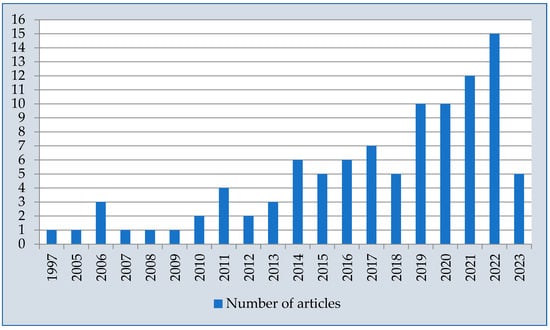
Figure 1.
Number of studies selected for evaluation by year of publication in all scientific research platforms consulted. Source: the authors (2024).
Results of the Systematic Review
Table 1 indicates how many articles were accepted and rejected at each level.
There has been a significant rise in the number of papers that research HTC in cities with high vertical expansion in the last decade, particularly after 2013. More than ten publications were published in the years 2020, 2021, and 2023, indicating that there is a stronger focus on HTC in urban contexts.
3.2. Data Meta-Analysis
The first feature aimed to analyze the origin of the works and the locations where the studies were conducted; hence, Figure 2 depicts the geographic distribution across 33 nations.
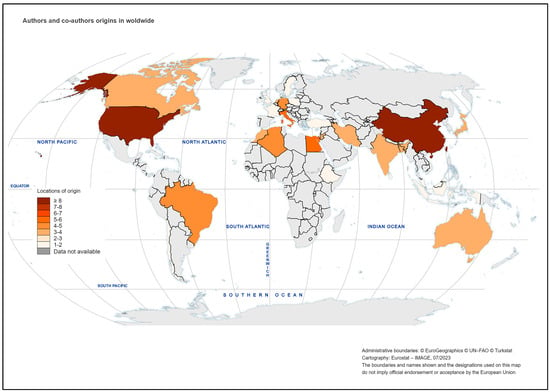
Figure 2.
Map of the global distribution of countries researching human thermal comfort in urban environments. Source: the authors (2024).
The geographical distribution of the works selected for reading and evaluation, as shown in the map, indicates a predominance of HTC investigations at the urban level in the Northern Hemisphere in 28 countries with a total of twenty-three articles, while Brazil, Australia, Chile, and Indonesia (since the study area is Jakarta, which is located in the Southern Hemisphere) have only nine published articles.
China had the greatest number of studies (twenty-eight articles); followed by the United States (eight); Algeria, Germany, and Brazil (four from each); Australia, Bangladesh, Egypt, Greece, India, Iran, and Singapore (three articles each); Canada, Israel, Japan, Morocco, Holland, and Singapore (two articles each); and Saudi Arabia, Chile, Cuba, Ethiopia, France, Hungary, Ireland, Indonesia, England, Israel, Malaysia, Poland, Sri Lanka, Sweden, Taiwan, Turkey, and Ethiopia (one article each).
The location element of urban regions was found in the most diverse cities in which the surveys were created; thus, it was classed in cities situated in locations distant from the coasts and coastal cities. Of the 100 articles reviewed, 68 were in urban regions situated in the nations’ more inland cities, while 32 were in cities near coastal metropolitan areas. Figure 3 depicts a graph of the urban areas’ proportions of continental and coastal locations.
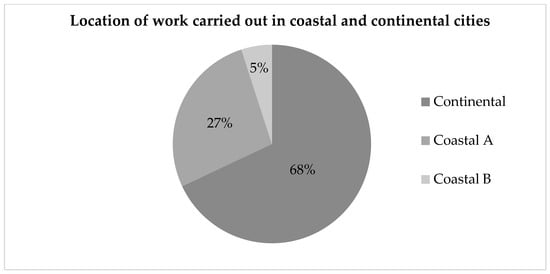
Figure 3.
Number of surveys carried out in coastal and continental cities. Source: the authors (2024).
The majority of the studies were conducted in metropolitan areas positioned further from the coast. Two scenarios were chosen for the coastal areas: Coastal Cities A and Coastal Cities B. The distinction was important since some works, even in coastal areas, took the closeness to the water into account while others did not. Coastal A: adjacent to significant bodies of water, although the presence of the sea was not taken into account in the assessment of thermal comfort in the urban area. Concerning the Coastal Cities B demarcation, they were works that had some link with the reality of marine proximity, although most of the time, they created subtle correlations without going into detail. Figure 4 presents the Köppen Climate Classification raised according to each study area in each research.
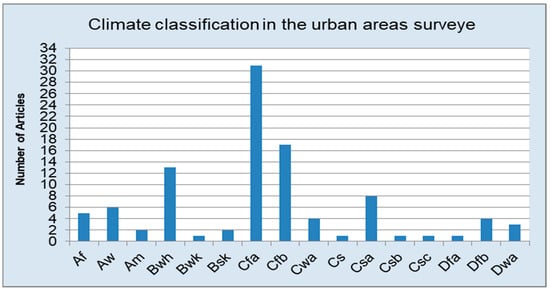
Figure 4.
Climate Classification of the areas of the cities addressed in the systematic review. Source: the authors (2024).
To characterize the research areas, the Köppen Climate Classification was employed, which typically represents the climatic environment in which the urban area studied is located. Cfa and Cfb were the most often utilized climatic categories, appearing 31 and 17 times, respectively. These were followed by Bwh (thirteen times), Csa (eight times), Aw (six), Af (five times), Cwa and Dfb (four times), Dwa (three times), Bsk and Am (two times), and Bwk, Cs, Dfa, Csb, and Csc (just once). Another key component in HTC study was the season of the year in which the surveys were conducted (Table 2), some of which were hybrid and others in only one season.

Table 2.
Set of seasons covered in the surveys.
Summer and winter seasons had the highest amount of study publications, with 70.29% (ninety-seven articles) utilizing summer and 21.73% (thirty articles) using winter, 3.62% (five articles) using spring, and 4.34% (six articles) using autumn. It should be emphasized that only six polls (6.19%) of the total were conducted during the year. Figure 4 depicts the Köppen Climatic Classifications for each survey’s second research region. The graph in Figure 5 depicts the daily duration of data collection used to calculate the thermal comfort indices.
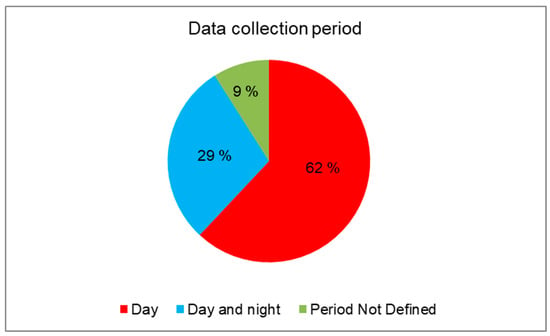
Figure 5.
Percentage of daily periods most addressed in research on human thermal comfort in urban areas. Source: the authors (2024).
The majority of the works collected and examined data during the day, accounting for (91.0%) of the surveys, with 29.0% of the surveys conducted during both the day and night time. Another 9.0% did not specify the time frame for the study. Figure 6 shows a table with the temperature indices utilized in the various studies.
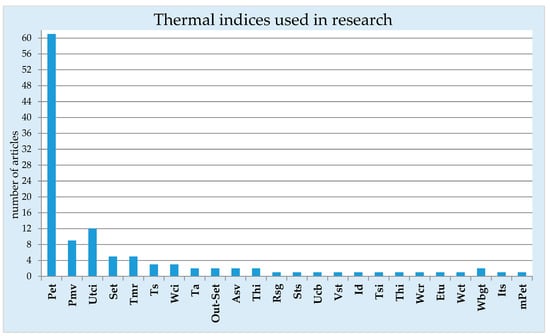
Figure 6.
HTC indexes most used in research in open areas. Source: the authors (2024).
The indices most used to measure HTC in open environments in highly verticalized cities in the works were Pet (sixty-one); Utci (twelve); Pmv (nine); Set (five); Trm (five); Ts (three); Wci (three); Ta, Out-Set, Asv, and Asv (two times each); Rsg, Ucb, Vst, Id, Tsi, Thi, Wcr, Etu, Wct, and mPet (used once each index). It is noteworthy that some articles used only the Trm to measure conditions for thermal comfort.
The definitions of application regions are highly significant in open environments and studies on thermal comfort in urban contexts, both with numerical models and in research that gathers interviews. Figure 7 depicts the characteristics used to determine the application zones in urban contexts. Verticalized landscapes with urban canyons were characterized as urban regions.
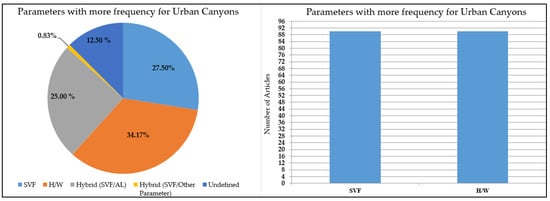
Figure 7.
Parameters used to define canyons in urban areas. Source: the authors (2023).
The H/W ratio was used ninety times to define and characterize the study areas, eighty times with the SVF, nineteen times with a hybrid strategy utilizing H/W with SVF, and just one time with a hybrid between SVF and another parameter. Figure 8 demonstrates how street orientation was used to describe the urban study environment, whereas Figure 9 depicts how meteorological data were gathered during surveys.
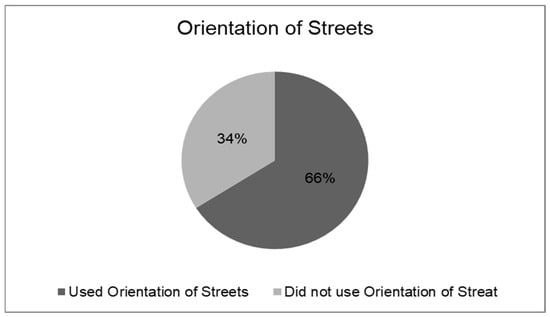
Figure 8.
Percentage of street orientation as an urban research environment criterion. Source: the authors (2024).
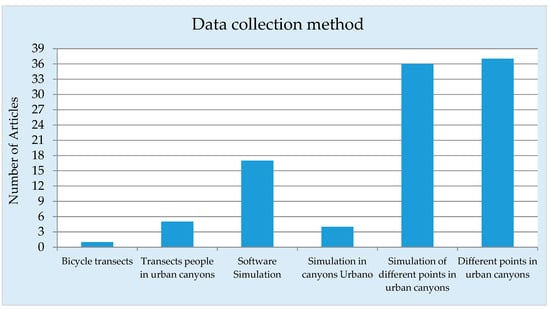
Figure 9.
Meteorological data collection methods. Source: the authors (2024).
According to Figure 8, a total of 66.0% (n = 66) studies employed street orientation as one of the methods to define the urban settings studied, with the change in orientation also influencing air temperature and human thermal comfort. Another 34.0% (n = 34) did not believe that the direction of the urban roadway impacted thermal comfort at the pedestrian level.
Data were simulated at different positions in canyons in 36 works, implying that data were acquired with meteorological devices from more than one site in the urban structure. The software simulations at various sites in canyons were carried out in recognized canyons using secondary data acquired from local weather stations. Four works included simulations of canyon building in software, three works had mobile transects of individuals walking in canyons, and one piece included a bicycle transect. Table 3 describes the various data-gathering methods. The equipment used to acquire meteorological data is depicted in Figure 10.

Table 3.
Description of ways of collecting meteorological data.
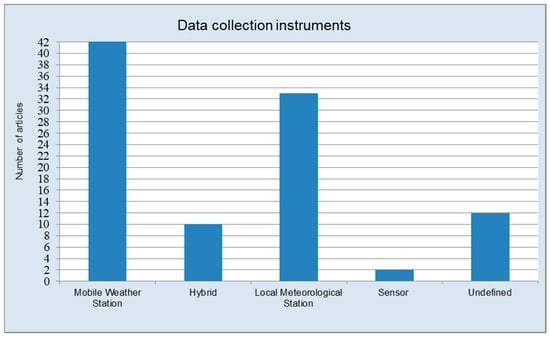
Figure 10.
Data collection instruments. Source: the authors (2024).
Data were collected with mobile meteorological stations added to the research environment 43 times, 33 times were from fixed local meteorological stations, primarily from airports, and 10 times were hybrid (with local collection and use of data from city stations). The form of data collection was not specified in the other 12 articles. Figure 11 depicts the software used as models to determine HTC indices.
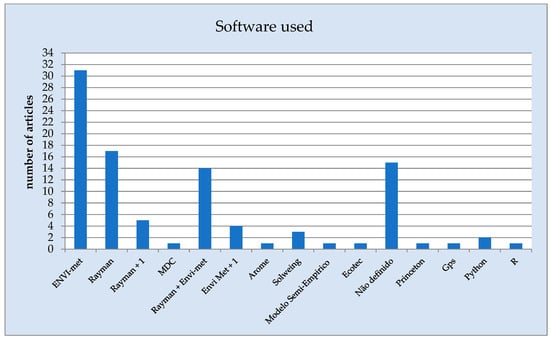
Figure 11.
Software used in surveys to determine human thermal comfort indices. Source: the authors (2024).
Envi-Met, which featured in 49 publications, and RayMan, which appeared in 36 articles, were the most commonly used software for data tabulation and computation of thermal comfort indices. The models were not recognized in 12 works, and the MDC, Arome, Semi-Empirico Model, Ecotec, Princeton, Gps, BioKlima, JMP15, Flair, R, Python, and ANSYS/Fluent® were only utilized once. Table 4 shows some of the research findings that only employed the H/W aspect and/or street orientation, and Table 5 resume the meaning of some acronyms used during the review.

Table 4.
Some investigations that exploited the H/W aspect and/or street orientation yielded research findings found in systematic review.

Table 5.
Presents the meaning of some acronyms used during the review.
Figure 12 depicts the number of works that employed questionnaire data collecting and the number of participants questioned.
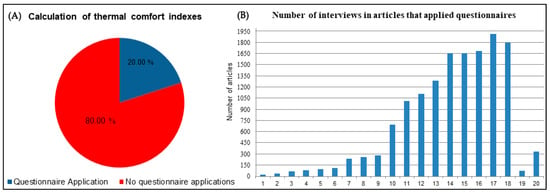
Figure 12.
(A) Percentage of surveys that used thermal preference questionnaires on pedestrians in urban areas and (B) number of people interviewed in each article. Source: The authors (2024).
Only 20.0% (20 articles) of the surveys employed interviews with individuals to calibrate the thermal indices used, whereas 80.0% (80 articles) calculated research indices of the population’s personal preference, and most simulations were performed with established parameters. The biggest number of interviews gathered among the 20 works was 1917 interviews, while the smallest number was 26 persons. All in all, eleven papers interviewed less than 1000 people, with just eight exceeding that number. Figure 13 depicts a map of the nations where pedestrians were questioned in urban settings.
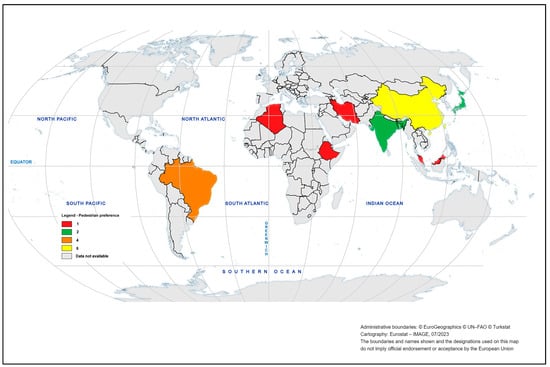
Figure 13.
Countries that conducted interviews with pedestrians in urban environments. Source: the authors (2024).
Only eight nations gathered pedestrian preferences. In the Northern Hemisphere, China has six articles; Bangladesh, India, and Japan each have two; and Algeria, Iran, and Malaysia each have one. Only Brazil published four studies with interviews of people outside in metropolitan settings in the Southern Hemisphere. Pet and Utci were the most often utilized thermal indices in studies on thermal comfort in outdoor urban environments. Figure 14 depicts which heat indices were used during human studies.
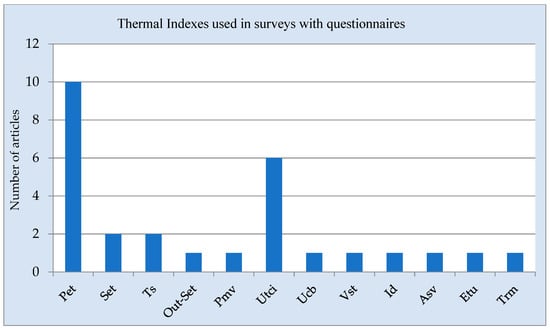
Figure 14.
Thermal indices used in research when they revealed the use of interviews in their procedures. Source: the authors (2024).
Pet and Utci were the most commonly used indices in publications that investigated thermal comfort in outdoor urban environments, with ten and six studies, respectively, using them. Other indices used were Set and TS in two articles, and Out-Set, Pmv, UCb, Vst, Id, Asv, and Etu once each. In six of the publications, more than one indicator was used to measure thermal comfort, whereas in eleven of the articles, only one index was employed. In terms of data-collecting time, 95.0% (nineteen articles) took place during the day, while only 5.0% (one article) conducted interviews that continued till the night.
4. Discussion
The urban environments with the highest concentration of research related to HTC in their open areas were predominantly located in the Northern Hemisphere, as well as in Europe, Asia, and the northern part of the African continent. It is thought that the process of urbanization of cities in the Northern Hemisphere’s continental sections has taken longer than that of cities in the Southern Hemisphere’s continents. However, according to [82], the Southern Hemisphere is quickly urbanizing, and the global south was responsible for 94% of the rise in the worldwide population between 2010 and 2015, and another especially intriguing statistic is that now, of the 33 global megacities, 27 are in the global south.
There has been a rise in the number of studies on HTC in metropolitan areas in recent years, particularly in the last decade. External areas must be of good quality and livable in order for people to carry out their daily activities in greater comfort [83]. Thus, a concern for cities’ and their inhabitants’ health arises, represented by HTC in outdoor spaces, which has been the subject of countless studies in recent decades, primarily in cities with a high degree of urbanization and verticalization [11,12,13,14,84,85,86].
The larger the number of studies that cover summer and daylight hours to evaluate HTC in metropolitan settings, the greater the worry about warming and climate change. Notably, a more focused concern about warmer times is justified, according to the Intergovernmental Panel on Climate Change (IPCC) [87] estimates, which show an increase in the world average temperature for the foreseeable future. While climate change affects all human populations, it can have the most dramatic consequences on large cities with higher population densities [87,88,89].
Urban parks influence exterior thermal comfort in the context of global warming, with the finding that metropolitan areas are warmer than surroundings and rural regions [90], owing mostly to the establishment of urban heat island effects (UHI). In light of climate change, the author suggests that managers must enhance realistic options for cooling urban parks.
Changing the morphology of cities affects environmental variables such as solar radiation, air temperature, humidity, and wind speed. To classify urban environments, [6] developed the Sky View Factor (SVF), and [91] developed the Height Relation x Width (H/W). These strategies are the primary methods for categorizing and defining urban regions in the urban climatic environment, as well as for defining urban canyons. It is worth noting that the SVF and the H/W ratio are both used as categorization processes in the LCZ technique.
The main key concept for determining urban canyons is the ratio calculated by calculating the average height between two buildings, which is given by the ratio between the average height of two buildings (A) divided by the width of the street between these two buildings (L) [41]. Some studies link the HTC to the proportion of canyons, such as [59] in Morocco, which found that deeper canyons provided better thermal conditions in the summer while shallow canyons provided better thermal conditions in the winter. Deep canyons, synonymous with shaded streets, have been shown to improve pedestrian thermal comfort in studies conducted by [32] in Beni-Isguen, Algeria; [33] in Colombo, Sri Lanka; [34] in Ghardaia, Algeria; [92] in Freiburg, Germany; and [93] in Taipei, Taiwan.
The SVF scaled from 0 to 1, with 1 being an open sky setting with no obstructions to shade the surfaces and 0 representing a state with a reduced capacity to view the sky [91,94]. According to Jamei et al. (2016) [95], the SVF within urban buildings is always less than 1 due to the existence of impediments generated by urban geometry.
Thermal indices developed for indoor environments may potentially be used to measure conditions in outdoor areas, with some changes required owing to the higher complexity of extra components. The authors of [96] discovered in a review that only four of the one hundred and sixty-five human thermal indices developed are widely used in research on thermal perception in open environments, namely the Physiological Equivalent Temperature (Pet), Predicted Mean Vote (Pmv), Universal Thermal Climate Index (Utci), and Standard Effective Temperature (Set), due to their applicability [96]. These indices were the most commonly employed in this systematic review, both in the overall evaluation and in the selection of papers that utilized indices calibrated using personal surveys.
5. Conclusions
The urban environments with the highest concentration of research related to HTC in their open areas were predominantly located in the Northern Hemisphere, as well as in Europe, Asia, and the northern part of the African continent, and only the United States and Canada in the northern portion of the American continent, countries considered already developed. It is thought that the process of urbanization of cities in the continental sections of the Northern Hemisphere is older and that is why cities have been consolidated for longer than the urbanization of countries in the Southern Hemisphere, which are still developing. However, according to [82], the Southern Hemisphere is rapidly urbanizing, and the global south was responsible for 94% of the increase in the world population between 2010 and 2015, and another especially intriguing statistic is that now, out of 33 megacities globally, 27 are in the global south. The three basic urban area categorization approaches are the H/W ratio, SVF, and LCZ. All these approaches are useful for categorizing urban areas, particularly those with compact and concentrated buildings, which is a prevalent feature of urbanized cities. The introduction of LCZs, a more recent and increasing categorization approach that includes both H/W and SVF on its platform, stands out. According to [97], it is becoming increasingly significant in urban climate research since it offers a universal categorization method for both natural and urban areas.
According to [98], urbanization originated in the Northern Hemisphere, both in North America and Western Europe, but it now occurs more strongly in emerging nations, which are largely in the Southern Hemisphere. According to the findings of this study, the majority of research on HTC in verticalized urban environments has been conducted in Northern Hemisphere cities, such as cities on the European continent, the Asian continent, China, and the North American continent, the United States. On the other hand, the HTC method is becoming more popular in urban regions than in nations in the Southern Hemisphere, with a focus on Brazil and Chile in Latin America and Australia in Oceania.
Author Contributions
Conceptualization, I.T.C., L.W., C.A.W. and J.P.A.G.; methodology, L.W., C.A.W., L.W., A.C.I., A.N.d.S., O.d.F.B. and J.P.A.G.; software, I.T.C., L.W. and C.A.W.; validation, I.T.C., C.A.W., L.W., A.C.I., A.N.d.S., O.d.F.B., J.P.A.G., S.S. and A.M.; formal analysis, A.M. and S.S.; investigation, I.T.C. and C.A.W.; resources, I.T.C. and C.A.W.; data curation, I.T.C., C.A.W. and J.P.A.G.; writing—original draft preparation, I.T.C. and C.A.W.; writing—review and editing, I.T.C., C.A.W., L.W., A.C.I., A.N.d.S., O.d.F.B., J.P.A.G., S.S. and A.M.; visualization, C.A.W., J.P.A.G., S.S. and A.M.; supervision, C.A.W., J.P.A.G., S.S. and A.M.; project administration, C.A.W.; funding acquisition, C.A.W. and S.S. All authors have read and agreed to the published version of the manuscript.
Funding
This study was financed in part by the Coordenação de Aperfeiçoamento de Pessoal de Nível Superior-Brasil (CAPES)-Finance Code 001. Conselho Nacional de Desenvolvimento Científico e Tecnológico (CNPq) for proving the Research and Productivity research: grant process number 306505/2020-7.
Data Availability Statement
The data presented in this study are available on request from the corresponding author (accurately indicate status).
Acknowledgments
We thank the Conselho Nacional de Desenvolvimento Científico e Tecnológico (CNPq) for proving the Research and Productivity research: grant process number 306505/2020-7.
Conflicts of Interest
The authors declare no conflicts of interest.
References
- Cárdenas-Jirón, L.A.; Graw, K.; Gangwisch, M.; Matzarakis, A. Influence of street configuration on human thermal comfort and benefits for climate-sensitive urban planning in Santiago de Chile. Urban Clim. 2023, 47, 101361. [Google Scholar] [CrossRef]
- Writzl, L.; Wollmann, C.A.; Costa, I.T.; Gobo, J.P.A.; Shooshtarian, S.; Matzarakis, A. Outdoor Human Thermal Comfort along Bike Paths in Balneário Camboriú/SC, Brazil. Atmosphere 2022, 13, 2092. [Google Scholar] [CrossRef]
- Vasilikou, C.; Nikolopoulou, M. Outdoor thermal comfort for pedestrians in movement: Thermal walks in complex urban morphology. Int. J. Biometeorol. 2020, 64, 277–291. [Google Scholar] [CrossRef]
- Vanos, J.K.; Kosaka, E.; Iida, A.; Yokohari, M.; Middel, A.; Scott-Fleming, I.; Brown, R.D. Planning for spectator thermal comfort and health in the face of extreme heat: The Tokyo 2020 Olympic marathons. Sci. Total Environ. 2019, 657, 904–917. [Google Scholar] [CrossRef]
- Wai, K.M.; Yuan, C.; Lai, A.; Peter, K.N. Relationship between pedestrian-level outdoor thermal comfort and building morphology in a high-density city. Sci. Total Environ. 2020, 708, 134516. [Google Scholar] [CrossRef] [PubMed]
- Oke, T.R. Boundary Layer Climates; Routledge: New York, NY, USA, 1978; 464p. [Google Scholar]
- Costa, I.T.; Wollmann, C.A.; Gobo, J.P.A.; Ikefuti, P.V.; Shooshtarian, S.; Matzarakis, A. Extreme weather conditions and cardiovascular hospitalizations in Southern Brazil. Sustainability 2021, 13, 12194. [Google Scholar] [CrossRef]
- Çağlak, S. Evaluation of the effects of thermal comfort conditions on cardiovascular diseases in Amasya City, Turkey. J. Public Health 2023, 31, 2011–2020. [Google Scholar] [CrossRef] [PubMed]
- Huang, K.T.; Li, Y.J. Impact of street canyon typology on building’s peak cooling energy demand: A parametric analysis using orthogonal experiment. Energy Build. 2017, 154, 448–464. [Google Scholar] [CrossRef]
- Givoni, B.; Noguchi, M.; Saaroni, H.; Pochter, O.; Yaacov, Y.; Feller, N.; Becker, S. Outdoor comfort research issues. Energy Build. 2003, 35, 77–86. [Google Scholar] [CrossRef]
- Stathopoulos, T.; Wu, H.; Zacharias, J. Outdoor human comfort in an urban climate. Build. Environ. 2004, 39, 297–305. [Google Scholar] [CrossRef]
- Maruani, T.; Amit-Cohen, I. Open space planning models: A review of approaches and methods. Landsc. Urban Plan. 2007, 81, 1–13. [Google Scholar] [CrossRef]
- Makaremi, N.; Salleh, E.; Jaafar, M.Z.; Ghaffarian Hoseini, A. Thermal comfort conditions of shaded outdoor spaces in hot and humid climate of Malaysia. Build. Environ. 2012, 48, 7–14. [Google Scholar] [CrossRef]
- Strømann-Andersen, J.; Sattrup, P.A. The urban canyon and building energy use: Urban density versus daylight and passive solar gains. Energy Build. 2011, 43, 2011–2020. [Google Scholar] [CrossRef]
- Ramires, J.C.; Gomes, E.R. Verticalização litorânea: Uma análise preliminar. Geografares 2002, 3, 91–107. [Google Scholar] [CrossRef]
- Scussel, M.C.B.; Sattler, M.A. Cidades em (trans) formação: Impacto da verticalização e densificação na qualidade do espaço residencial. Ambiente Construído 2010, 10, 137–150. [Google Scholar] [CrossRef]
- Auliciems, A. Human Bioclimatology; Springer: Berlin/Heidelberg, Germany, 1998; Volume 5. [Google Scholar]
- Oke, T.R.; Mills, G.; Christen, A.; Voogt, A. Urban Climates; Cambridge University Press: Cambridge, UK, 2017. [Google Scholar]
- Shooshtarian, S.; Lam, C.K.C.; Kenawy, I. Outdoor thermal comfort assessment: A review on thermal comfort research in Australia. Build. Environ. 2020, 177, 106917. [Google Scholar] [CrossRef]
- Wai, C.Y.; Tariq, M.A.U.R.; Muttil, N. A Systematic Review on the Existing Research, Practices, and Prospects Regarding Urban Green Infrastructure for Thermal Comfort in a High-Density Urban Context. Water 2022, 14, 2496. [Google Scholar] [CrossRef]
- Dissanayake, C.; Weerasinghe, U.G.D. Urban microclimate and outdoor thermal comfort of public spaces in warm-humid cities: A comparative bibliometric mapping of the literature. Am. J. Clim. Change 2021, 10, 433–466. [Google Scholar] [CrossRef]
- Stewart, I.D. A systematic review and scientific critique of methodology in modern urban heat island literature. Int. J. Climatol. 2011, 31, 200–217. [Google Scholar] [CrossRef]
- Hunt, M. How Science Takes Stock: The Story of Meta-Analysis; Russell Sage Foundation: New York, NY, USA, 1997. [Google Scholar]
- Higgins, J.; Green, S. (Eds.) Cochrane Handbook for Systematic Reviews of Interventions, Version 5.1.0; [updated March 2011]; The Cochrane Collaboration: London, UK, 2011. [Google Scholar]
- Medina, E.U.; Pailaquilén, R.M.B. A revisão sistemática e a sua relação com a prática baseada na evidência em saúde. Rev. Lat.-Am. Enferm. 2010, 18, 824–831. [Google Scholar]
- Guanilo, M.C.T.; Takahashi, R.F.; Bertolozzi, M. R Revisão sistemática: Noções gerais. Rev. Esc. Enferm. USP 2011, 45, 1260–1266. [Google Scholar] [CrossRef] [PubMed]
- Akobeng, A.K. Understanding systematic reviews and meta-analysis. Arch. Dis. Child. 2005, 90, 845–848. [Google Scholar] [CrossRef] [PubMed]
- Paul, J.; Criado, A.R. The art of writing literature review: What do we know and what do we need to know? Int. Bus. Rev. 2020, 29, 101717. [Google Scholar] [CrossRef]
- Sampaio, R.F.; Mancini, M.C. Estudos de revisão sistemática: Um guia para síntese criteriosa da evidência científica. Braz. J. Phys. Ther. 2007, 11, 83–89. [Google Scholar] [CrossRef]
- Silva, A.N.D. Interações Topoclimáticas Entre o Urbano e o Parque Natural Municipal dos Morros, em Santa Maria/RS. 2022. Dissertação (Mestrado)—Universidade Federal de Santa Maria, Centro de Ciências Naturais e Exatas, Programa de Pós-Graduação em Geografia, RS. 2022. Available online: http://repositorio.ufsm.br/handle/1/23765 (accessed on 9 February 2024).
- Writzl, L. Conforto Térmico Humano em Caminhos Disponíveis ao uso da Bicicleta em Balneário Camboriú-SC, em Situação Veranil. 2022. Writzl, L. Conforto Térmico Humano em Caminhos Disponíveis ao Uso da Bicicleta em Balneário Camboriú-SC, em Situação Veranil. 2022. Available online: http://repositorio.ufsm.br/handle/1/26320 (accessed on 9 February 2024).
- Ali-Toudert, F.; Djenane, M.; Bensalem, R.; Mayer, H. Outdoor thermal comfort in the old desert city of Beni-Isguen, Algeria. Clim. Res. 2005, 28, 243–256. [Google Scholar] [CrossRef]
- Emmanuel, R.; Johansson, E. Influence of urban morphology and sea breeze on hot humid microclimate: The case of Colombo, Sri Lanka. Clim. Res. 2006, 30, 189–200. [Google Scholar] [CrossRef]
- Ali-Toudert, F.; Mayer, H. Numerical study on the effects of aspect ratio and orientation of an urban street canyon on outdoor thermal comfort in hot and dry climate. Build. Environ. 2006, 41, 94–108. [Google Scholar] [CrossRef]
- Ma, X.; Fukuda, H.; Zhou, D.; Gao, W.; Wang, M. The study on outdoor pedestrian thermal comfort in blocks: A case study of the Dao He Old Block in hot-summer and cold-winter area of southern China. Sol. Energy 2019, 179, 210–225. [Google Scholar] [CrossRef]
- Jamei, E.; Rajagopalan, P. Urban development and pedestrian thermal comfort in Melbourne. Sol. Energy 2017, 144, 681–698. [Google Scholar] [CrossRef]
- Chatzidimitriou, A.; Yannas, S. Street canyon design and improvement potential for urban open spaces; the influence of canyon aspect ratio and orientation on microclimate and outdoor comfort. Sustain. Cities Soc. 2017, 33, 85–101. [Google Scholar] [CrossRef]
- Rodríguez-Algeciras, J.; Tablada, A.; Matzarakis, A. Effect of asymmetrical street canyons on pedestrian thermal comfort in warm-humid climate of Cuba. Theor. Appl. Climatol. 2018, 133, 663–679. [Google Scholar] [CrossRef]
- Bochenek, A.; Klemm, K. Assessment of human thermal comfort in street canyons. An example of typical structures (Lodz, Poland). Bud. O Zoptymalizowanym Potencjale Energetycznym 2020, 9, 69–76. [Google Scholar] [CrossRef]
- Gaber, N.; Ibrahim, A.; Rashad, A.B.; Wahba, E.; El-Sayad, Z.; Bakr, A.F. Improving pedestrian micro-climate in urban canyons: City Center of Alexandria, Egypt. Urban Clim. 2020, 34, 100670. [Google Scholar] [CrossRef]
- Krüger, E.L.; Minella, F.O.; Rasia, F. Impact of urban geometry on outdoor thermal comfort and air quality from field measurements in Curitiba, Brazil. Build. Environ. 2011, 46, 621–634. [Google Scholar] [CrossRef]
- Ma, X.; Fukuda, H.; Zhou, D.; Wang, M. A Study of the Pedestrianized Zone for Tourists: Urban Design Effects on Humans’ Thermal Comfort in Foshan City, Southern China. Sustainability 2019, 11, 2774. [Google Scholar] [CrossRef]
- Kakon, A.N.; Nobuo, M.; Kojima, S.; Yoko, T. Assessment of thermal comfort in respect to building height in a high-density city in the tropics. Am. J. Eng. Appl. Sci. 2010, 3, 545–551. [Google Scholar] [CrossRef]
- Lee, H.; Mayer, H.; Kuttler, W. Impact of the spacing between tree crowns on the mitigation of daytime heat stress for pedestrians inside EW urban street canyons under Central European conditions. Urban For. Urban Green. 2020, 48, 126558. [Google Scholar] [CrossRef]
- Abdelhafez, M.H.H.; Altaf, F.; Alshenaifi, M.; Hamdy, O.; Ragab, A. Achieving Effective Thermal Performance of Street Canyons in Various Climatic Zones. Sustainability 2022, 14, 10780. [Google Scholar] [CrossRef]
- Abd Elraouf, R.; Elmokadem, A.; Megahed, N.; Eleinen, O.A.; Eltarabily, S. The impact of urban geometry on outdoor thermal comfort in a hot-humid climate. Build. Environ. 2022, 225, 109632. [Google Scholar] [CrossRef]
- Abdollahzadeh, N.; Biloria, N. Outdoor thermal comfort: Analyzing the impact of urban configurations on the thermal performance of street canyons in the humid subtropical climate of Sydney. Front. Archit. Res. 2021, 10, 394–409. [Google Scholar] [CrossRef]
- Abdallah, A.S.H.; Mahmoud, R.M.A. Urban morphology as an adaptation strategy to improve outdoor thermal comfort in urban residential community of new Assiut city, Egypt. Sustain. Cities Soc. 2022, 78, 103648. [Google Scholar] [CrossRef]
- Kim, Y.J.; Brown, R.D. A multilevel approach for assessing the effects of microclimatic urban design on pedestrian thermal comfort: The High Line in New York. Build. Environ. 2021, 205, 108244. [Google Scholar] [CrossRef]
- Li, Z.; Zhang, H.; Juan, Y.H.; Wen, C.Y.; Yang, A.S. Effects of building setback on thermal comfort and air quality in the street canyon. Build. Environ. 2022, 208, 108627. [Google Scholar] [CrossRef]
- Vassiliades, C.; Savvides, A.; Buonomano, A. Building integration of active solar energy systems for façades renovation in the urban fabric: Effects on the thermal comfort in outdoor public spaces in Naples and Thessaloniki. Renew. Energy 2022, 190, 30–47. [Google Scholar] [CrossRef]
- Acero, J.A.; Koh, E.J.; Ruefenacht, L.A.; Norford, L.K. Modelling the influence of high-rise urban geometry on outdoor thermal comfort in Singapore. Urban Clim. 2021, 36, 100775. [Google Scholar] [CrossRef]
- Al Haddid, H.; Al-Obaidi, K.M. Examining the impact of urban canyons morphology on outdoor environmental conditions in city centres with a temperate climate. Energy Nexus 2022, 8, 100159. [Google Scholar] [CrossRef]
- Mahmoud, H.; Ghanem, H.; Sodoudi, S. Urban geometry as an adaptation strategy to improve the outdoor thermal performance in hot arid regions: Aswan University as a case study. Sustain. Cities Soc. 2021, 71, 102965. [Google Scholar] [CrossRef]
- Abreu-Harbich, L.V.; Labaki, L.C.; Sampaio, V.H.P.; Labaki, L.C.; Matzarakis, A. Influência de diferentes configurações urbanas no conforto térmico em cânions urbanos de Campinas, SP—Estudos de campo e simulações Computacionais. In Proceedings of the Encontro Nacional de Tecnologia do Ambiente Construído, Maceio, Brazil, 12–14 November 2014; Available online: http://dkimrg/10.17012/entac2014.275 (accessed on 9 February 2024).
- Boumaraf, H.; Amireche, L. Thermal comfort and pedestrian behaviors in urban public spaces in cities with warm and dry climates. Open House Int. 2021, 46, 143–159. [Google Scholar] [CrossRef]
- Lamarca, C.; Qüense, J.; Henríquez, C. Thermal comfort and urban canyons morphology in coastal temperate climate, Concepción, Chile. Urban Clim. 2018, 23, 159–172. [Google Scholar] [CrossRef]
- Watanabe, S.; Nagano, K.; Ishii, J.; Horikoshi, T. Evaluation of outdoor thermal comfort in sunlight, building shade, and pergola shade during summer in a humid subtropical region. Build. Environ. 2014, 82, 556–565. [Google Scholar] [CrossRef]
- Johansson, E. Influence of urban geometry on outdoor thermal comfort in a hot dry climate: A study in Fez, Morocco. Build. Environ. 2006, 41, 1326–1338. [Google Scholar] [CrossRef]
- Paolini, R.; Mainini, A.G.; Poli, T.; Vercesi, L. Assessment of thermal stress in a street canyon in pedestrian area with or without canopy shading. Energy Procedia 2014, 48, 1570–1575. [Google Scholar] [CrossRef]
- Sun, C.; Lian, W.; Liu, L.; Dong, Q.; Han, Y. The impact of street geometry on outdoor thermal comfort within three different urban forms in severe cold region of China. Build. Environ. 2022, 222, 109342. [Google Scholar] [CrossRef]
- Athamena, K. Microclimatic coupling to assess the impact of crossing urban form on outdoor thermal comfort in temperate oceanic climate. Urban Clim. 2022, 42, 101093. [Google Scholar] [CrossRef]
- Din, M.F.M.; Lee, Y.Y.; Ponraj, M.; Ossen, D.R.; Iwao, K.; Chelliapan, S. Thermal comfort of various building layouts with a proposed discomfort index range for tropical climate. J. Therm. Biol. 2014, 41, 6–15. [Google Scholar] [CrossRef]
- Gadish, I.; Saaroni, H.; Pearlmutter, D. A predictive analysis of thermal stress in a densifying urban business district under summer daytime conditions in a Mediterranean City. Urban Clim. 2023, 48, 101298. [Google Scholar] [CrossRef]
- Lau, K.K.L.; Chung, S.C.; Ren, C. Outdoor thermal comfort in different urban settings of sub-tropical high-density cities: An approach of adopting local climate zone (LCZ) classification. Build. Environ. 2019, 154, 227–238. [Google Scholar] [CrossRef]
- Yan, H.; Wu, F.; Nan, X.; Han, Q.; Shao, F.; Bao, Z. Influence of view factors on intra-urban air temperature and thermal comfort variability in a temperate city. Sci. Total Environ. 2022, 841, 156720. [Google Scholar] [CrossRef]
- Deevi, B.; Chundeli, F.A. Quantitative outdoor thermal comfort assessment of street: A case in a warm and humid climate of India. Urban Clim. 2020, 34, 100718. [Google Scholar] [CrossRef]
- Jihad, A.S.; Tahiri, M. Modeling the urban geometry influence on outdoor thermal comfort in the case of Moroccan microclimate. Urban Clim. 2016, 16, 25–42. [Google Scholar] [CrossRef]
- Limona, S.S.; Al-hagla, K.S.; El-sayad, Z.T. Using simulation methods to investigate the impact of urban form on human comfort. Case study: Coast of Baltim, North Coast, Egypt. Alex. Eng. J. 2019, 58, 273–282. [Google Scholar] [CrossRef]
- Hwang, R.L.; Lin, T.P.; Matzarakis, A. Seasonal effects of urban street shading on long-term outdoor thermal comfort. Build. Environ. 2011, 46, 863–870. [Google Scholar] [CrossRef]
- Yin, S.; Lang, W.; Xiao, Y. The synergistic effect of street canyons and neighbourhood layout design on pedestrian-level thermal comfort in hot-humid area of China. Sustain. Cities Soc. 2019, 49, 101571. [Google Scholar] [CrossRef]
- Chen, L.; Yu, B.; Yang, F.; Mayer, H. Intra-urban differences of mean radiant temperature in different urban settings in Shanghai and implications for heat stress under heat waves: A GIS-based approach. Energy Build. 2016, 130, 829–842. [Google Scholar] [CrossRef]
- Rosheidat, A.; Hoffman, D.; Bryan, H. Visualizing pedestrian comfort using ENVI-met. Proc. SimBuild 2008, 3, 198–205. [Google Scholar]
- Pioppi, B.; Pigliautile, I.; Pisello, A.L. Human-centric microclimate analysis of Urban Heat Island: Wearable sensing and data-driven techniques for identifying mitigation strategies in New York City. Urban Clim. 2020, 34, 100716. [Google Scholar] [CrossRef]
- Mirzaei, P.A.; Haghighat, F. A procedure to quantify the impact of mitigation techniques on the urban ventilation. Build. Environ. 2012, 47, 410–420. [Google Scholar] [CrossRef]
- Latini, G.; Grifoni, R.C.; Tascini, S. Thermal comfort and microclimates in open spaces. Build. XI 2010, 79, 5–9. [Google Scholar]
- Krüger, E. Impact of site-specific morphology on outdoor thermal perception: A case-study in a subtropical location. Urban Clim. 2017, 21, 123–135. [Google Scholar] [CrossRef]
- Croce, S.; D’Agnolo, E.; Caini, M.; Paparella, R. The use of cool pavements for the regeneration of industrial districts. Sustainability 2021, 13, 6322. [Google Scholar] [CrossRef]
- Yao, J.; Yang, F.; Zhuang, Z.; Shao, Y.; Yuan, P.F. The effect of personal and microclimatic variables on outdoor thermal comfort: A field study in a cold season in Lujiazui CBD, Shanghai. Sustain. Cities Soc. 2018, 39, 181–188. [Google Scholar] [CrossRef]
- Deng, X.; Cao, Q.; Wang, L.; Wang, W.; Wang, S.; Wang, L. Understanding the Impact of Urban Expansion and Lake Shrinkage on Summer Climate and Human Thermal Comfort in a Land-Water Mosaic Area. J. Geophys. Res. Atmos. 2022, 127, e2021JD036131. [Google Scholar] [CrossRef]
- Liu, Z.; Zhao, X.; Jin, Y.; Jin, H.; Xu, X. Prediction of outdoor human thermal sensation at the pedestrian level in high-rise residential areas in severe cold regions of China. Energy Procedia 2019, 157, 51–58. [Google Scholar] [CrossRef]
- Smit, W. Urbanização no Sul Global. In Em Oxford Research Encyclopedia of Global Public Health; Oxford University Press: Oxford, UK, 2021. [Google Scholar]
- Huang, T.; Li, J.; Xie, Y.; Niu, J.; Mak, C.M. Simultaneous environmental parameter monitoring and human subject survey regarding outdoor thermal comfort and its modelling. Build. Environ. 2017, 125, 502–514. [Google Scholar] [CrossRef]
- Lai, A.; Maing, M.; Ng, E. Observational studies of mean radiant temperature across different outdoor spaces under shaded conditions in densely built environment. Build. Environ. 2017, 114, 397–409. [Google Scholar] [CrossRef]
- Hegazy, I.R.; Qurnfulah, E.M. Thermal comfort of urban spaces using simulation tools exploring street orientation influence of on the outdoor thermal comfort: A case study of Jeddah, Saudi Arabia. Int. J. Low-Carbon Technol. 2020, 15, 594–606. [Google Scholar] [CrossRef]
- Sanagar Darbani, E.; Monsefi Parapari, D.; Boland, J.; Sharifi, E. Impacts of urban form and urban heat island on the outdoor thermal comfort: A pilot study on Mashhad. Int. J. Biometeorol. 2021, 65, 1101–1117. [Google Scholar] [CrossRef]
- IPCC. 2007 Climate Change: The Physical Science Basis. Summary for Policymakers; Contribution of Working Group I to the 4th Assessment Report of the Intergovernmental Panel on Climate Change; Solomon, S., Qin, D., Manning, M., Chen, Z., Marquis, M., Averyt, K.B., Tignor, M., Miller, H.L., Eds.; Cambridge University Press: Cambridge, UK, 2007; Available online: http://www.ipcc.ch (accessed on 12 February 2023).
- Bulkeley, H. Cities and climate change. In Cities and Climate Change; Taylor and Francis: Abingdon, UK, 2013. [Google Scholar] [CrossRef]
- IPCC. Special Report on Climate Change and Land. IPCC, August 2017. 2019. Available online: https://www.ipcc.ch/report/srccl (accessed on 9 February 2024).
- Aram, F.; Solgi, E.; Garcia, E.H.; Mosavi, A. Urban heat resilience at the time of global warming: Evaluating the impact of the urban parks on outdoor thermal comfort. Environ. Sci. Eur. 2020, 32, 117. [Google Scholar] [CrossRef]
- Oke, T.R. Street design and urban canopy layer climate. Energy Build. 1988, 11, 103–113. [Google Scholar] [CrossRef]
- Ali-Toudert, F.; Mayer, H. Thermal comfort in an east–west oriented street canyon in Freiburg (Germany) under hot summer conditions. Theor. Appl. Climatol. 2007, 87, 223–237. [Google Scholar] [CrossRef]
- Chen, Y.C.; Lin, P.H.; Matzarakis, A. Vertical variability of thermal comfort in urban areas: The example of Taipei 101. Meteorol. Z. 2013, 22, 753–759. [Google Scholar] [CrossRef]
- Chapman, L.; Thornes, J.E. Real-time sky-view factor calculation and approximation. J. Atmos. Ocean. Technol. 2004, 21, 730–741. [Google Scholar] [CrossRef]
- Jamei, E.; Rajagopalan, P.; Seyedmahmoudian, M.; Jamei, Y. Review on the impact of urban geometry and pedestrian level greening on outdoor thermal comfort. Renew. Sustain. Energy Rev. 2016, 54, 1002–1017. [Google Scholar] [CrossRef]
- Potchter, O.; Cohen, P.; Lin, T.P.; Matzarakis, A. Outdoor human thermal perception in various climates: A comprehensive review of approaches, methods and quantification. Sci. Total Environ. 2018, 631, 390–406. [Google Scholar] [CrossRef]
- Huang, F.; Jiang, S.; Zhan, W.; Bechtel, B.; Liu, Z.; Demuzere, M.; Huang, Y.; Xu, Y.; Ma, L.; Xia, W.; et al. Mapping local climate zones for cities: A large review. Remote Sens. Environ. 2023, 292, 113573. [Google Scholar] [CrossRef]
- Lederbogen, F.; Kirsch, P.; Haddad, L.; Streit, F.; Tost, H.; Schuch, P.; Wüst, S.; Pruessner, J.C.; Rietschel, M.; Deuschle, M.; et al. City living and urban upbringing affect neural social stress processing in humans. Nature 2011, 474, 498–501. [Google Scholar] [CrossRef]
Disclaimer/Publisher’s Note: The statements, opinions and data contained in all publications are solely those of the individual author(s) and contributor(s) and not of MDPI and/or the editor(s). MDPI and/or the editor(s) disclaim responsibility for any injury to people or property resulting from any ideas, methods, instructions or products referred to in the content. |
© 2024 by the authors. Licensee MDPI, Basel, Switzerland. This article is an open access article distributed under the terms and conditions of the Creative Commons Attribution (CC BY) license (https://creativecommons.org/licenses/by/4.0/).